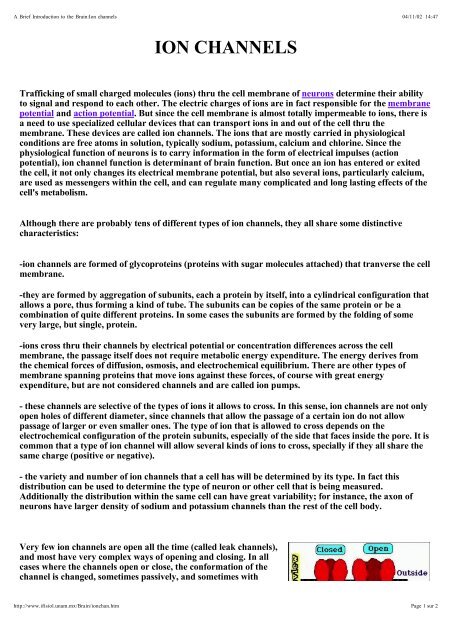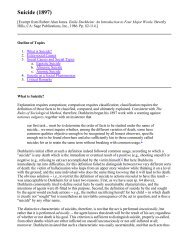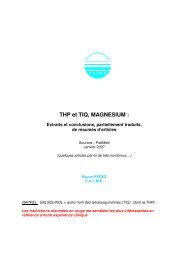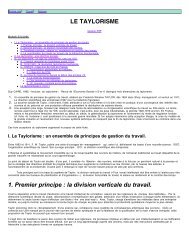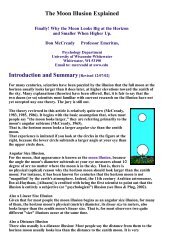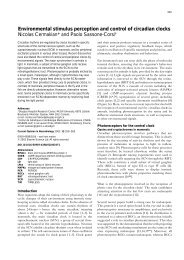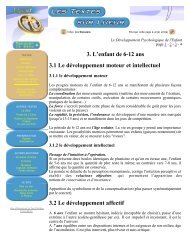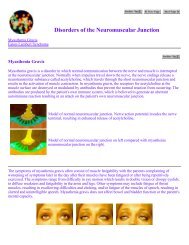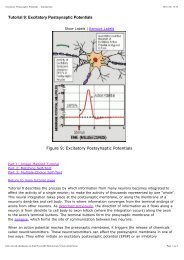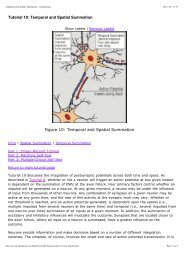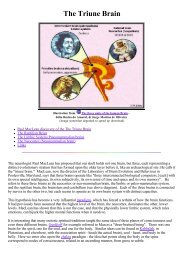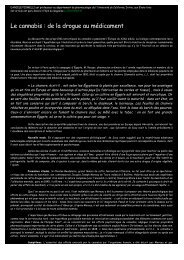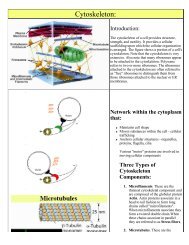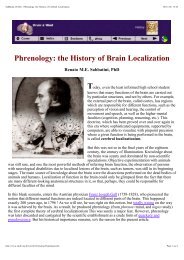You also want an ePaper? Increase the reach of your titles
YUMPU automatically turns print PDFs into web optimized ePapers that Google loves.
A Brief Introduction to the Brain:Ion channels<br />
<strong>ION</strong> <strong>CHANNELS</strong><br />
Trafficking of small charged molecules (ions) thru the cell membrane of neurons determine their ability<br />
to signal and respond to each other. The electric charges of ions are in fact responsible for the membrane<br />
potential and action potential.<br />
But since the cell membrane is almost totally impermeable to ions, there is<br />
a need to use specialized cellular devices that can transport ions in and out of the cell thru the<br />
membrane. These devices are called ion channels. The ions that are mostly carried in physiological<br />
conditions are free atoms in solution, typically sodium, potassium, calcium and chlorine. Since the<br />
physiological function of neurons is to carry information in the form of electrical impulses (action<br />
potential), ion channel function is determinant of brain function. But once an ion has entered or exited<br />
the cell, it not only changes its electrical membrane potential, but also several ions, particularly calcium,<br />
are used as messengers within the cell, and can regulate many complicated and long lasting effects of the<br />
cell's metabolism.<br />
Although there are probably tens of different types of ion channels, they all share some distinctive<br />
characteristics:<br />
-ion channels are formed of glycoproteins (proteins with sugar molecules attached) that tranverse the cell<br />
membrane.<br />
-they are formed by aggregation of subunits, each a protein by itself, into a cylindrical configuration that<br />
allows a pore, thus forming a kind of tube. The subunits can be copies of the same protein or be a<br />
combination of quite different proteins. In some cases the subunits are formed by the folding of some<br />
very large, but single, protein.<br />
-ions cross thru their channels by electrical potential or concentration differences across the cell<br />
membrane, the passage itself does not require metabolic energy expenditure. The energy derives from<br />
the chemical forces of diffusion, osmosis, and electrochemical equilibrium. There are other types of<br />
membrane spanning proteins that move ions against these forces, of course with great energy<br />
expenditure, but are not considered channels and are called ion pumps.<br />
- these channels are selective of the types of ions it allows to cross. In this sense, ion channels are not only<br />
open holes of different diameter, since channels that allow the passage of a certain ion do not allow<br />
passage of larger or even smaller ones. The type of ion that is allowed to cross depends on the<br />
electrochemical configuration of the protein subunits, especially of the side that faces inside the pore. It is<br />
common that a type of ion channel will allow several kinds of ions to cross, specially if they all share the<br />
same charge (positive or negative).<br />
- the variety and number of ion channels that a cell has will be determined by its type. In fact this<br />
distribution can be used to determine the type of neuron or other cell that is being measured.<br />
Additionally the distribution within the same cell can have great variability; for instance, the axon of<br />
neurons have larger density of sodium and potassium channels than the rest of the cell body.<br />
Very few ion channels are open all the time (called leak channels),<br />
and most have very complex ways of opening and closing. In all<br />
cases where the channels open or close, the conformation of the<br />
channel is changed, sometimes passively, and sometimes with<br />
http://www.ifisiol.unam.mx/Brain/ionchan.htm<br />
04/11/02 14:47<br />
Page 1 sur 2
A Brief Introduction to the Brain:Ion channels<br />
energy expenditure. What is changed exactly depends on the type<br />
of channel, but in all cases it must involve the blockade of the pore.<br />
Sometimes channels change some physical aspect inside the pore,<br />
thus leaving no space for ion flux, and sometimes the change<br />
involves a different distribution of charges inside the pore that<br />
constrain passage of charged particles. The open or closed state in<br />
which a channel can be (gating) depends on signals coming from<br />
either inside or outside the cell. It is very common for a channel's<br />
gating to be controlled by the membrane potential (the difference between the total outer and inner<br />
charges), opening or closing when changes occur and a certain threshold is crossed. Another common<br />
type of gating is by a ligand binding to a receptor in the channel. Receptors are mentioned in another<br />
document, but basically consist of sections of a protein that allow very specific molecules to bind, and<br />
causing it to change conformation. The ligand can come from outside of the cell or from an inner<br />
message, and it is not uncommon that a single ion channel has several receptors for the same type of<br />
ligand or even for very different types, thus allowing very complex cellular signaling resulting in either<br />
the opening or closure of the channel. These types of receptor-ion channel complexes are usually<br />
classified not as types of channels but as receptors having an associated ion channel (ionotropic<br />
receptors), but it is just a nomenclature discrepancy. Another signal that can control gating takes<br />
advantage of the fact that most protein metabolism depends on the phosphorylation by enzymes. A<br />
phosphorylated protein has more energy and can therefore withstand some configurations in shape and<br />
charge that cannot exist when not phosphorylated. Gating can happen whenever the proteins that<br />
conform the subunits of the channel are phosphorylated or not. n<br />
Different mechanisms for the opening or closing of ion channels<br />
1.- By phosphorylation and desphosphorylation or the protein,<br />
structural changes can be achieved.<br />
2.- The coupling of a messenger (typically a neurotransmitter),<br />
causes<br />
it to open. These are called direct gated receptors, or ionotropic<br />
receptors.<br />
3.- The change in membrane potential can cause a conformational<br />
change. These are the voltage sensitive channels.<br />
Go to the list of topics<br />
http://www.ifisiol.unam.mx/Brain/ionchan.htm<br />
04/11/02 14:47<br />
Page 2 sur 2


